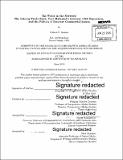| dc.contributor.advisor | William Charles Uricchio. | en_US |
| dc.contributor.author | Kaman, Colleen E | en_US |
| dc.contributor.other | Massachusetts Institute of Technology. Department of Comparative Media Studies. | en_US |
| dc.date.accessioned | 2015-09-02T15:28:34Z | |
| dc.date.available | 2015-09-02T15:28:34Z | |
| dc.date.copyright | 2010 | en_US |
| dc.date.issued | 2010 | en_US |
| dc.identifier.uri | http://hdl.handle.net/1721.1/98338 | |
| dc.description | Thesis: S.M., Massachusetts Institute of Technology, Department of Comparative Media Studies, 2010. | en_US |
| dc.description | Cataloged from PDF version of thesis. | en_US |
| dc.description | Includes bibliographical references (pages 90-94). | en_US |
| dc.description.abstract | In the early 1990s, the Internet emerged as a commercially viable global communications medium. This study considers the role that representatives of the military-industrial research world played in the physical expansion of the Internet. It does so by examining the social practices and processes of the semi-annual "Interop" computer-networking trade show, and one affiliated "exposition." Beginning in 1987, and for nearly a decade, Interop operated as a forum that brought representatives from industry and the research and user communities into strategic alliance to tackle the practicalities of expanding the Internet's core networking protocols and assembling diverse networks into a global Internet. The period examined culminates with the Internet 1996 World Exposition. Through that event, technologist Carl Malamud drew on the rhetoric of turn-of-the-century world's fairs to demonstrate the value of faster networks but also argued for a conception of "the commons" that could ideally be served by the rapidly privatizing Internet. In the absence of a comprehensive history of the commercial expansion of the Internet, analysis of these practices provides a pioneering analytic narrative of a crucial strand of this development. This thesis moves between levels of analysis, specifically between the Interop network, the Internet 1996 Exposition event, and the perspective of Malamud himself. By highlighting these hitherto neglected practices, this examination deepens our understanding of the forces that proved critical to the Internet's commercial success. | en_US |
| dc.description.statementofresponsibility | by Colleen E. Kaman. | en_US |
| dc.format.extent | 94 pages | en_US |
| dc.language.iso | eng | en_US |
| dc.publisher | Massachusetts Institute of Technology | en_US |
| dc.rights | M.I.T. theses are protected by copyright. They may be viewed from this source for any purpose, but reproduction or distribution in any format is prohibited without written permission. See provided URL for inquiries about permission. | en_US |
| dc.rights.uri | http://dspace.mit.edu/handle/1721.1/7582 | en_US |
| dc.subject | Comparative Media Studies. | en_US |
| dc.title | The world in the network: the Interop trade show, Carl Malamud's Internet 1996 Exposition, and the politics of internet commercialization | en_US |
| dc.title.alternative | Interop trade show, Carl Malamud's Internet 1996 Exposition, and the politics of internet commercialization | en_US |
| dc.type | Thesis | en_US |
| dc.description.degree | S.M. | en_US |
| dc.contributor.department | Massachusetts Institute of Technology. Program in Comparative Media Studies/Writing | en_US |
| dc.identifier.oclc | 919209342 | en_US |
